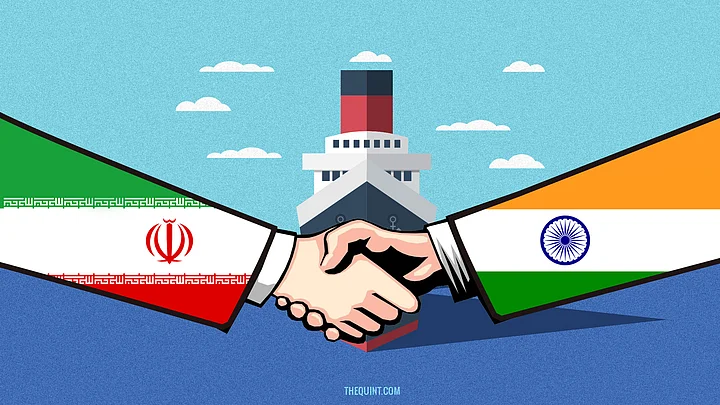A momentous strategic event unveiled for India on Sunday, 3 December, when Iran’s President Hassan Rouhani inaugurated the first phase of the Chabahar port development project. This will enhance trade in the region with a final aim to connect not just to Afghanistan via rail, but also to the 7,200 International North South
Transport Corridor to Russia. Chabahar would also allow the Indian Navy to keep a close eye on Chinese vessels moving in and out of Pakistan’s Gwadar port.
Incidentally, the Chabahar port has already been put to use by India on 11 November when the first consignment of 15,000 tonnes from Kandla port was transported to Zaranj (Afghanistan) via Chabahar. Currently, India is using the port’s existing commercial route to transport to send more than 1.1 million tonnes of wheat to Afghanistan.
The 3 December inauguration ceremony of the first phase of Chabahar port has effectively paved the way for India to carry forward the next phase of construction and development of two berths for its use, particularly for trade to Afghanistan. In fact, reaching out to Afghanistan is one of the prime strategic objectives of the Chabahar port project for India.
The next hope for the stakeholders is that India – which has committed $500 million to the project – will develop a free trade area around the port, and finally will complete the loop with a $1.6 billion railway line to Zahedan.
The first part of India’s construction is scheduled to be finished in 2018. India has already completed the Zaranj-Delaram highway in Afghanistan, which would facilitate the trade to Kabul and eventually to Central Asia. Iranian Parliament or Majlis recently ratified the trilateral trade agreement signed by Prime Minister Narendra Modi, President Rouhani and Afghanistan President Ashraf Ghani in May 2016.
Chabahar’s Strategic Importance
While Pakistan’s Gwadar port has allowed China unfettered access to the Arabian Sea and Indian Ocean, and allows its Navy to patrol the seas largely unchallenged, the Chabahar port too is strategically located.
It lies in the Arabian Sea, merging with the Indian Ocean. Chabahar, in time, could become an alternative port for India’s re-export market to the Middle East and North Africa region. At the moment, Dubai is India’s hub for re-exports.
The Chabahar port is located about 100 kilometres from Gwadar. India planned to pump around $600 million into Chabahar port development in the first phase and substantial investments have already been made since Prime Minister's Narendra Modi's Tehran visit in 2016.
Strategic Pitfalls and the US Factor
India importing US crude and cutting down on its oil imports from Iran could have some serious repercussions as far as India's strategic plans in the region are concerned. Iran is fuming at India for letting it down at a time when every oil exporting country is trying to retain its share of the oil market, given the global supply glut.
International oil trade analyst Himendra Kumar says the development of Chabahar seaport could have a damaging impact on India. India wants to develop quickly to counter Pakistan's Gwadar port developed by China that serves China's maritime trade interests with the Middle East and North Africa region and bolsters its naval presence in the Arabian Sea and beyond.
But in its eagerness to forge closer ties with the Trump Administration, India should not become a pawn in the American fight against Tehran, which the US has long identified as an ‘axis of evil’. The US wants to dry up Iran’s supply of dollars and deplete its foreign exchange reserves to the farthest extent possible so that its domestic inflation spirals out of control, thereby setting the stage for a popular uprising. And oil, a dollar-traded commodity, is Iran’s biggest export item.
However, a caution from Himendra Kumar is worth factoring in. He says that while Iran wouldn't say a direct no to Indian investments in Chabahar as it needs the dollars, they may put up a roadblock at a crucial stage unless India comes up with a mega-investment plan for Iran to counter its short-sighted US policy that almost threatens bilateral ties with its time-tested oil supplier. Iran is India's third-largest oil exporter, and India imports nearly four-fifths of its oil needs.
India should not forget that the Iranians are known to be champion stonewallers. For example, Iran successfully stonewalled US efforts to halt its nuclear programme for years and eventually succeeded in its foreign policy objective of putting an end to its international isolation.
Iran is capable of leaving India high and dry by pouring cold water on its strategic plans linked to Chabahar if New Delhi doesn’t up its game with Tehran soon.
Leverage Over Pakistan
Through Chabahar, India wants to sever land-locked Afghanistan from its dependence on Pakistan for the bulk of its imports. India counts on Afghanistan as a close ally in its Pakistan policy. The Chabahar port, 800 kilometres closer to Afghanistan than Pakistan's Karachi port, is intended to provide an alternative for trade between India and Afghanistan.
It’s in India's strategic interest to keep Iran in good humour for many reasons, and Chabahar port is definitely one of those.
(Rajeev Sharma is an independent journalist and strategic affairs analyst who tweets @Kishkindha. This is an opinion piece and the views expressed above are the author’s own. The Quint neither endorses nor is responsible for the same.)
